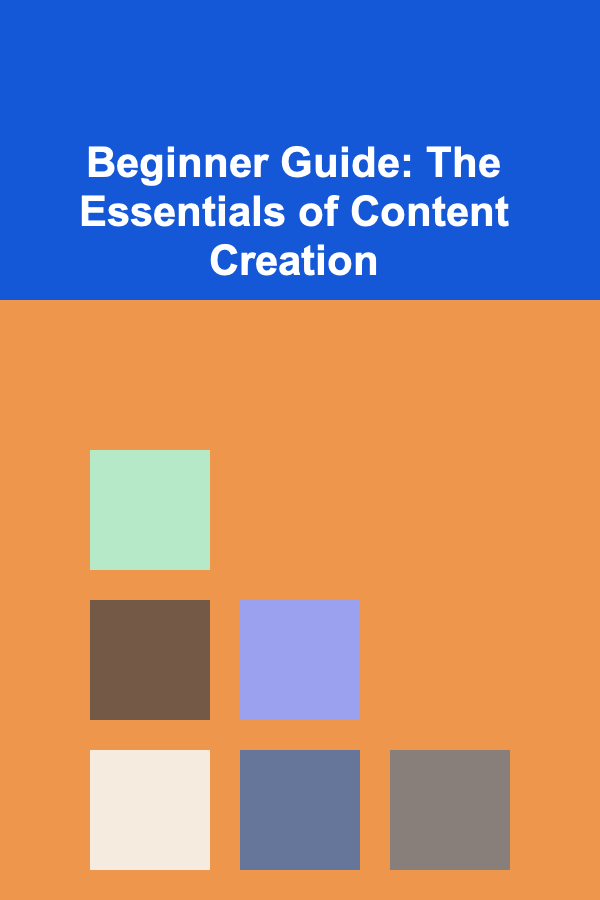
How to Plan YouTube Content for Different Audience Segments
ebook include PDF & Audio bundle (Micro Guide)
$12.99$11.99
Limited Time Offer! Order within the next:
Not available at this time

Creating content for YouTube is more than just publishing videos --- it's about delivering engaging, relevant material to the right audience. Understanding how to plan and create YouTube content for different audience segments is crucial to maximizing engagement, growing your channel, and building a loyal community. In this article, we'll explore how to tailor your YouTube content strategy for various audience segments, focusing on how to analyze and connect with these different groups.
Understanding Your Audience
Before planning your content, it's essential to understand who your audience is. YouTube's user base is vast, with people of different ages, interests, and backgrounds. By identifying your target audience segments, you can create content that resonates with them, driving engagement and fostering long-term success.
1. Demographics and Psychographics
When analyzing your audience, start with basic demographic data, such as age, gender, location, and language. From there, delve deeper into psychographics --- the interests, values, and behaviors that influence how your audience engages with content.
- Age Groups: Different age segments have varying interests. For instance, teenagers might enjoy pop culture and gaming videos, while older viewers may prefer content related to finance, health, or lifestyle.
- Interest Segmentation: Understanding the specific interests within your audience allows you to create highly targeted content. For example, if you have an audience passionate about cooking, segment this group further into baking enthusiasts or home chefs, tailoring your content accordingly.
- Behavioral Data: Tools like YouTube Analytics allow you to see how viewers interact with your videos. This includes metrics like watch time, frequency of visits, and which types of content result in the most engagement.
Understanding these variables helps in creating content that aligns with your audience's specific needs and expectations.
2. Creating Audience Personas
One of the most effective ways to understand your audience is by developing audience personas. These are fictional characters based on research and data, representing different segments of your audience.
Each persona should include:
- Demographics (age, location, etc.)
- Goals and interests
- Challenges and pain points
- Preferred content format (vlogs, tutorials, challenges, etc.)
For example, a persona might be "Emma, a 25-year-old urban professional who enjoys beauty and wellness content." By having detailed personas, you can create content specifically aimed at addressing their interests and needs.
Content Planning Strategies for Different Audience Segments
Once you have a clear understanding of your audience, it's time to tailor your content strategy to suit their preferences. Here's how to plan your YouTube content for various audience segments:
1. Younger Audiences (Teens to Young Adults)
Younger viewers are the lifeblood of YouTube. This segment, typically in their teens to early 20s, is known for its passion for trends, challenges, and entertainment.
Content Ideas for Younger Audiences:
- Trend-based Content: Participate in viral challenges, reaction videos, and trending topics. These videos tend to attract younger viewers looking for the latest buzz.
- Gaming Content: Gaming videos, such as Let's Plays, walkthroughs, and game reviews, are immensely popular with this group.
- Pop Culture and Celebrity News: Teenagers and young adults are particularly invested in pop culture. Reaction videos, celebrity gossip, and commentary on TV shows, movies, and music will captivate their attention.
- Interactive Content: Create opportunities for audience interaction, such as Q&A sessions, polls, and "choose your own adventure" type videos where they can influence the content.
Content Characteristics:
- Fun, informal tone
- High-energy editing
- Shorter video lengths (around 8--12 minutes)
- Focus on current events or challenges
2. Mature Audiences (Adults 35+)
Mature audiences are likely to engage with content that provides value, such as tutorials, informational videos, and entertainment that resonates with their life stage. They might be interested in topics such as family, career growth, or health.
Content Ideas for Mature Audiences:
- How-To Guides and Tutorials: For adults looking to improve their skills, a tutorial on topics like home improvement, budgeting, or cooking can be highly engaging.
- Product Reviews: This age group often relies on research before making purchases. In-depth reviews of tech gadgets, kitchen appliances, or even books are a great way to attract mature viewers.
- Lifestyle and Wellness: Content that focuses on health, fitness, mental wellness, and work-life balance is particularly appealing to this segment.
- Documentaries and Long-Form Content: Mature viewers often appreciate content that provides a deep dive into a particular topic, such as historical events, personal finance, or life stories.
Content Characteristics:
- Informative, with a clear value proposition
- Higher production value, well-researched content
- Longer videos (15 minutes or more)
- Focus on professionalism and respectfulness
3. Niche Audiences
Niche audiences are those who have very specific interests. Whether it's a particular hobby, profession, or subculture, these groups appreciate content tailored to their passion.
Content Ideas for Niche Audiences:
- Hobby-Centric Content: Whether it's knitting, gardening, or collecting vintage toys, creating content around a specific hobby can be incredibly rewarding. Videos might include tutorials, product reviews, or discussions about trends within the niche.
- Deep Dives into Specialized Topics: Niche audiences value in-depth analysis and expert opinions. Content that educates or solves problems within their niche will keep them coming back for more.
- Community Building: Foster a sense of community by responding to comments, organizing challenges, or encouraging discussions within the niche.
Content Characteristics:
- Highly targeted content
- Enthusiastic and passionate delivery
- Regular uploads to stay top-of-mind in niche communities
- Content might be more technical or specialized
4. Global Audiences
If you're aiming to build an international following, it's important to think globally and understand the cultural nuances of different regions.
Content Ideas for Global Audiences:
- Language-Specific Content: If possible, create content in different languages to reach a wider audience. For example, if you create content about technology, try producing both English and Spanish versions of your videos.
- Cultural Sensitivity: Be mindful of cultural differences and create content that resonates with viewers from different countries. For instance, global travel content or "day-in-the-life" videos showcasing various cultures can be engaging.
- International Trends: Leverage global trends or challenges that have viral appeal worldwide. Trending hashtags and global events can help your content reach a broader audience.
Content Characteristics:
- Multi-language subtitles
- Cultural inclusivity and sensitivity
- A focus on global trends or universal themes
Creating a Content Calendar for Different Segments
Once you've identified your audience segments, the next step is organizing your content. A well-structured content calendar is key to ensuring that you maintain consistency while addressing the needs of each segment.
1. Balance Content for Multiple Audiences
It's important to strike a balance when planning your content. For example, if you have both younger and mature audiences, ensure you schedule videos that appeal to both groups. This might include alternating content based on age demographics or creating series that cater to different interests.
2. Optimize Video Titles, Thumbnails, and Descriptions
For each segment, make sure your titles, thumbnails, and video descriptions reflect the preferences and language of the audience. Younger viewers may prefer fun, eye-catching thumbnails and emojis in titles, while mature audiences may prefer more straightforward, professional-looking visuals.
3. Consistency is Key
Maintain a consistent posting schedule to keep your audience engaged. Regular uploads --- whether daily, weekly, or bi-weekly --- ensure that your audience knows when to expect new content, which keeps them coming back.
Engaging with Your Audience
Audience interaction is a key part of maintaining engagement. Respond to comments, ask for feedback, and make your audience feel heard. For different segments, you might want to tailor your engagement strategies:
- Young Adults: Engage with them through polls, Instagram stories, or behind-the-scenes content.
- Mature Audiences: Encourage thoughtful discussion in the comments or ask for suggestions on content that addresses their challenges.
- Niche Audiences: Foster a sense of community by responding to specific queries, hosting live streams, or creating forums for discussions.
Conclusion
Planning YouTube content for different audience segments requires careful consideration of your audience's demographics, preferences, and needs. By understanding who your viewers are, you can create tailored content that resonates with them, drives engagement, and fosters community. With a strategic content plan, a well-maintained content calendar, and effective audience interaction, you'll be able to grow your YouTube channel and achieve long-term success.

Beginner Guide: The Essentials of Content Creation
Read More
How to Plan a Kid-Friendly Home Party That's Fun for Everyone
Read More
How to Store and Organize Your Photography Equipment
Read More
How to Create a System for Knowledge Management
Read More
Motivating Underperforming Employees: A Deep Dive
Read More
How to Monitor Your Credit Card Activity for Suspicion
Read MoreOther Products

Beginner Guide: The Essentials of Content Creation
Read More
How to Plan a Kid-Friendly Home Party That's Fun for Everyone
Read More
How to Store and Organize Your Photography Equipment
Read More
How to Create a System for Knowledge Management
Read More
Motivating Underperforming Employees: A Deep Dive
Read More